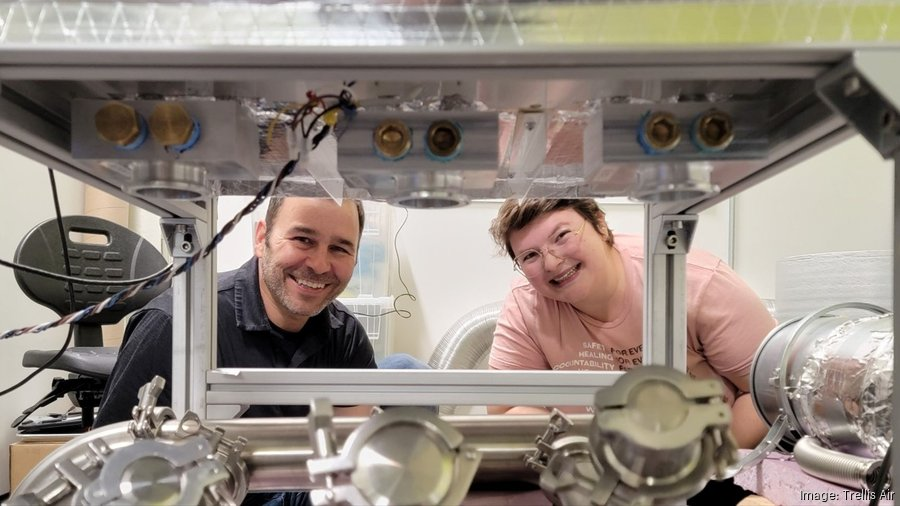Trellis Air Technology: A Game Changer in Cooling Solutions

Trellis Air technology represents a groundbreaking leap in sustainable cooling solutions, specifically designed to combat the escalating demand for energy-efficient air conditioning amid climate change. Developed by an innovative Harvard startup, this novel approach utilizes advanced membrane dehumidification, akin to a coffee filter, for more efficient moisture removal from the air. As countries grapple with rising temperatures, Trellis Air’s system offers a compelling climate change solution that not only reduces energy consumption but also curtails greenhouse gas emissions significantly. With projections showing that air conditioning demand could soar by 40 percent by 2030, Trellis Air technology stands out as a pivotal player in reimagining how we approach cooling in our buildings. This innovation merges cutting-edge science with practical engineering, setting the stage for a new era in environmentally conscious climate management.
Innovative cooling systems are becoming increasingly essential as global temperatures rise, and one standout approach is Trellis Air technology. This groundbreaking method employs membrane-based dehumidification that enhances the efficiency of air conditioning systems while minimizing energy use and environmental impact. As a leading example of Harvard startup innovation, Trellis Air is strategically positioned to address the urgent need for sustainable cooling technology in an era where traditional methods contribute significantly to climate change. By efficiently separating moisture from the air, this technology not only offers a fresh perspective on energy-efficient cooling but also demonstrates a proactive response to the mounting challenges posed by climate change. Overall, Trellis Air’s revolutionary approach could reshape the future of indoor air management and energy consumption.
The Role of Trellis Air Technology in Combatting Climate Change
Trellis Air technology represents a pivotal shift in the landscape of energy-efficient air conditioning systems, integral to reducing the substantial greenhouse gas emissions generated by conventional cooling methods. With current air conditioning systems accounting for around 4% of global emissions, innovative solutions like Trellis Air offer a promising path toward sustainability. By employing a unique membrane-based approach to dehumidification, Trellis Air effectively minimizes the energy required to operate cooling systems, providing a tangible solution to the escalating demand for air conditioning driven by climate change.
Through its groundbreaking design, which functions similarly to a coffee filter, Trellis Air extracts moisture from the air with significantly reduced energy consumption. This efficiency not only lowers operational costs but also diminishes reliance on harmful refrigerants that contribute to climate change. As climate projections continue to indicate rising temperatures, technologies like Trellis Air are not just preferred; they become essential components in the fight against climate change, reducing our carbon footprint while catering to soaring cooling demands.
Advancements in Membrane Dehumidification Technology
The introduction of membrane dehumidification systems marks a significant breakthrough in cooling technology, overcoming previous limitations faced by earlier attempts in the field. Traditional dehumidifiers consume large amounts of energy and often employ methods that are less efficient and more harmful to the environment. Trellis Air’s innovative membrane, developed by a team of leading scientists at Harvard, boasts high water selectivity and durability, transforming the way moisture is extracted from air. This technology not only enhances efficiency but also extends the lifespan of cooling systems.
With the membrane being just 15 microns thick—thinner than a human hair—Trellis Air’s design allows for remarkable efficiency in moisture removal while maintaining robust performance. In contrast to older desiccant systems, which tend to struggle with scalability, Trellis Air capitalizes on advanced materials science and engineering techniques to deliver an innovative, sustainable cooling solution. This advancement exemplifies how combining science with practical engineering can yield significant developments in sustainable technology.
Sustainable Cooling Technologies for Future Needs
As demands for air conditioning escalate in response to climate change, innovative and sustainable cooling technologies like those offered by Trellis Air are imperative. Traditional cooling systems often lead to escalating energy consumption, directly contributing to higher greenhouse gas emissions. Trellis Air’s method not only circumvents these issues by employing a significantly more efficient dehumidification process but also positions itself as a proactive solution to future climate-related challenges.
Moreover, these sustainable cooling technologies are not just environmentally friendly; they also pave the way for new business opportunities and markets. As companies pivot toward green business practices, integrating Trellis Air technology can significantly enhance their sustainability profiles. This shift toward sustainable cooling also aligns with broader societal goals of minimizing the impact of climate change, highlighting the vital role that innovative products can play in achieving these objectives.
Energy-Efficient Air Conditioning: A Demand Surge by 2030
Research indicates that the demand for air conditioning is projected to increase by up to 40% by 2030, driven by factors such as rising global temperatures and population growth in hot climates. This surge presents a pressing challenge: how to meet increasing cooling needs without exacerbating climate change. Trellis Air’s energy-efficient approach to air conditioning is poised to meet this challenge head-on. By tapping into advanced membrane technology, Trellis Air provides a solution that not only cools spaces more efficiently but also uses significantly less energy compared to conventional systems.
Addressing the energy consumption of air conditioning systems is crucial for mitigating their environmental impact. Trellis Air aims to integrate their technology into existing frameworks, transforming traditional air conditioning units into more efficient systems. By functioning as a ‘pre-drying module’, Trellis Air’s innovation enables air conditioners to operate more efficiently, thereby conserving energy and reducing emissions, ultimately leading to a more sustainable future.
Harvard’s Role in Climate Change Solutions
The innovative research conducted at Harvard University plays a crucial role in developing solutions for climate change impacts, particularly through entrepreneurship and technology transfer initiatives like those seen with Trellis Air. The collaboration between various departments underscores the university’s commitment to addressing global challenges, combining academia and industry expertise to foster advancements in sustainable technology. By supporting startups focused on climate solutions, Harvard is positioning itself at the forefront of innovation that addresses pressing environmental issues.
Furthermore, the backing of programs such as the Wyss Institute for Biologically Inspired Engineering and the Office of Technology Development demonstrates Harvard’s proactive engagement in climate change solutions. As research translates into viable business opportunities, the university not only contributes academically but also actively engages in creating market-ready innovations like Trellis Air that aim to revolutionize the cooling industry while significantly aiding in climate mitigation efforts.
New Approaches to Dehumidification: The Third Way
Historically, cooling technology has relied heavily on vapor-compression systems or desiccant drying methods. Trellis Air introduces a groundbreaking third way by leveraging advanced membrane technology for dehumidification, setting itself apart from traditional methods. This innovative approach offers a reduction in energy consumption and environmental impact, reflecting a significant advancement in the air conditioning sector. By effectively separating water vapor from the air, Trellis Air responds to the need for more sustainable, energy-efficient cooling solutions.
The unique characteristics of Trellis Air’s membrane enable it to perform similarly to a traditional cooling system but with significantly fewer energy requirements. This revolution in dehumidification not only enhances the comfort of indoor environments but also addresses the larger issue of energy use and emissions in the context of global climate change. As cities and communities grapple with the impacts of a warming planet, such novel technologies will be crucial in transitioning toward a greener, more sustainable future.
Lessons from Harvard’s Startup Culture
The journey of Trellis Air is indicative of a broader trend seen within Harvard’s ecosystem—fostering innovation through collaboration and entrepreneurial spirit. The support from various research departments and funding initiatives allows for a conducive environment where groundbreaking solutions can emerge. Such a culture not only breeds cutting-edge technology but also encourages a mindset focused on sustainability and climate change solutions, emphasizing the importance of innovation in addressing global challenges.
Moreover, the success of startups like Trellis Air illustrates how clear pathways from research to commercialization can effectively bridge the gap between theoretical science and practical application. With seasoned entrepreneurs taking the helm and scientists providing critical insight, this model encourages the development of solutions that are both impactful and commercially viable. It highlights Harvard’s role in nurturing the next generation of technologies aimed at mitigating the effects of climate change.
Overcoming Challenges in Membrane Technology
Despite the promising potential of membrane dehumidification technologies, significant challenges have thwarted their widespread implementation in the past. Key issues such as the need for scalable and robust materials have posed obstacles for previous attempts at developing viable systems. However, Trellis Air has successfully navigated these challenges through innovative engineering, resulting in a durable membrane that achieves high selectivity and efficiency. This advancement is a testament to the collaborative efforts at Harvard, where interdisciplinary knowledge plays a crucial role in overcoming technical barriers.
The unique design of Trellis Air’s membrane system not only enhances moisture extraction capabilities but also ensures longevity in real-world applications. By utilizing state-of-the-art materials and engineering techniques, Trellis Air pushes the boundaries of what is possible in sustainable cooling technology. This focus on overcoming existing challenges paves the way for broader acceptance and integration of membrane dehumidification systems in various settings, ultimately contributing to a more energy-efficient future for air conditioning.
Future of Air Conditioning with Trellis Air
Looking forward, Trellis Air is set to revolutionize the air conditioning industry by integrating its innovative technology into a variety of applications. From residential systems to large-scale industrial uses, the potential for this technology extends far beyond traditional confines. By promoting energy-efficient and sustainable cooling methods, Trellis Air addresses not only the immediate needs for comfortable indoor environments but also aligns with long-term goals for environmental sustainability.
With pathways identified for commercialization, Trellis Air’s future looks promising as it aims to replace inefficient desiccant systems and enhance the performance of existing air conditioning units. As the company moves towards larger-scale production and implementation, it will not only have a transformative impact on the air conditioning market but also serve as a key player in the overall fight against climate change. By adapting to modern challenges, Trellis Air heralds a new era of sustainable cooling technologies that aim to mitigate the energy crisis and environmental damage associated with traditional cooling methods.
Frequently Asked Questions
What is Trellis Air technology and how does it work?
Trellis Air technology refers to a novel membrane dehumidification system developed by a Harvard startup designed to enhance energy-efficient air conditioning. This innovative technology functions similarly to a coffee filter by separating water vapor from the air, allowing for cooler and drier air to be circulated without the high energy costs associated with traditional air conditioning systems. It represents a breakthrough in sustainable cooling technology, aiming to reduce energy consumption significantly.
How does membrane dehumidification contribute to climate change solutions?
Membrane dehumidification, as utilized by Trellis Air technology, plays a crucial role in climate change solutions by significantly lowering the energy required for cooling buildings. Traditional air conditioning systems are responsible for around 4% of global greenhouse gas emissions. By reducing energy usage during the cooling process, Trellis Air technology not only curtails these emissions but also promotes sustainable cooling practices essential for combating climate change.
Why is Trellis Air technology considered energy-efficient compared to traditional systems?
Trellis Air technology is considered energy-efficient because it utilizes a specialized membrane to remove humidity from the air directly, reducing the reliance on energy-intensive refrigerants found in traditional air conditioning units. This innovative system operates more like a high-performance dehumidifier, minimizing unnecessary energy consumption and enhancing overall cooling efficiency, which is vital for maintaining comfortable indoor environments as global temperatures rise.
What are the potential applications of Trellis Air technology in residential and industrial settings?
Trellis Air technology has wide-ranging applications, both in residential and industrial settings. For homes, it can replace conventional basement dehumidifiers, providing a more energy-efficient solution. In industrial environments, it may serve as a substitute for traditional desiccant systems, enhancing the drying processes of sensitive materials. Ultimately, the goal is to integrate Trellis Air’s technology into existing air conditioning systems for global deployment.
How does Trellis Air align with the goal of sustainable cooling technology?
Trellis Air aligns with the goal of sustainable cooling technology by offering an innovative approach that drastically reduces the energy footprint of air conditioning. By minimizing greenhouse gas emissions and optimizing energy use, this technology not only addresses the demand for cooling as climate change progresses but also contributes to the larger vision of a sustainable future in building climate control.
Who are the key innovators behind Trellis Air technology?
Trellis Air technology is the product of collaborative efforts from various experts at Harvard University, including Jonathan Grinham, an assistant professor of architecture, and Jack Alvarenga, a staff scientist. Their work, supported by the Wyss Institute and Harvard’s Office of Technology Development, combined raw scientific research with engineering breakthroughs, enabling the development of this innovative membrane-based cooling solution.
What challenges does Trellis Air technology aim to address in the air conditioning industry?
Trellis Air technology addresses several challenges in the air conditioning industry, including high energy consumption, reliance on harmful refrigerants, and significant greenhouse gas emissions. As demand for cooling rises due to climate change, Trellis Air seeks to modernize outdated cooling solutions and provide a more efficient, environmentally friendly alternative that can meet the increasing air conditioning needs of the future.
What role did funding from the Department of Energy play in developing Trellis Air technology?
Funding from the Department of Energy was instrumental in the development of Trellis Air technology, allowing researchers to conduct essential foundational studies and create a viable commercial prototype. This support facilitated the transition from lab-based research to real-world applications, enabling successful pilot tests that demonstrated the technology’s potential for efficient cooling solutions.
| Key Point | Details |
|---|---|
| Trellis Air Technology | A novel membrane system developed by Harvard that enhances dehumidification and energy efficiency in cooling systems. |
| Climate Challenge | Current cooling systems contribute 4% of global greenhouse gas emissions, which is double the emissions from air travel. |
| Innovative Approach | Unlike traditional systems, Trellis Air’s technology acts like a coffee filter, efficiently separating water vapor from air with less energy. |
| Partnerships | The development involved collaboration across various Harvard departments, enhancing scientific and engineering breakthroughs. |
| Prototyping | Field trials in Miami and at Harvard tested the technology’s effectiveness in real-world conditions. |
| Commercialization Paths | Potential applications include replacing desiccant systems, retrofitting dehumidifiers, and enhancing air conditioning systems globally. |
| Funding Support | Initial research and development funded by the Department of Energy, National Science Foundation, and Harvard’s Office of Technology Development. |
Summary
Trellis Air technology represents a significant advancement in air conditioning innovation aimed at combatting climate change. By efficiently removing moisture from the air and utilizing energy-saving membranes, this groundbreaking system can drastically reduce the carbon footprint of cooling solutions worldwide. As demand for air conditioning continues to rise, Trellis Air provides a sustainable alternative that promises to reshape how we cool our environments, making it a crucial player in the fight against global warming.





